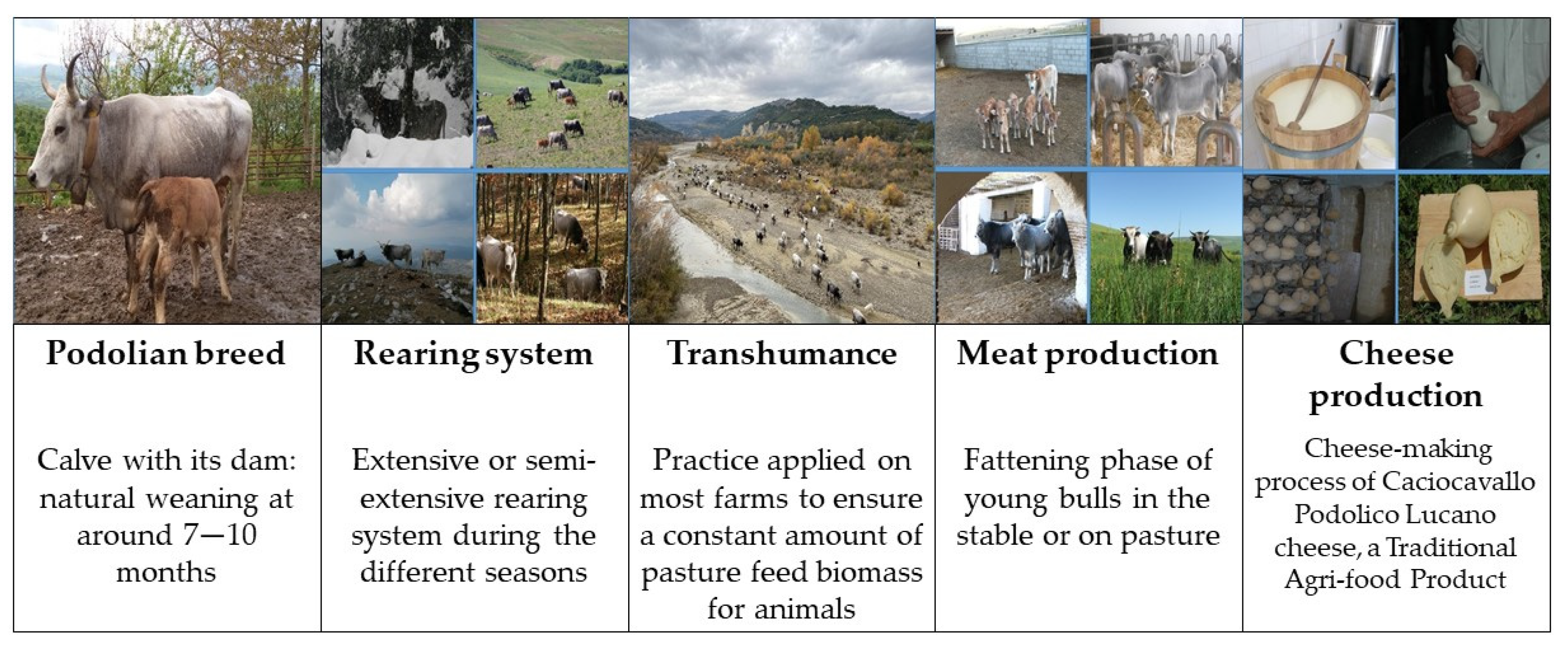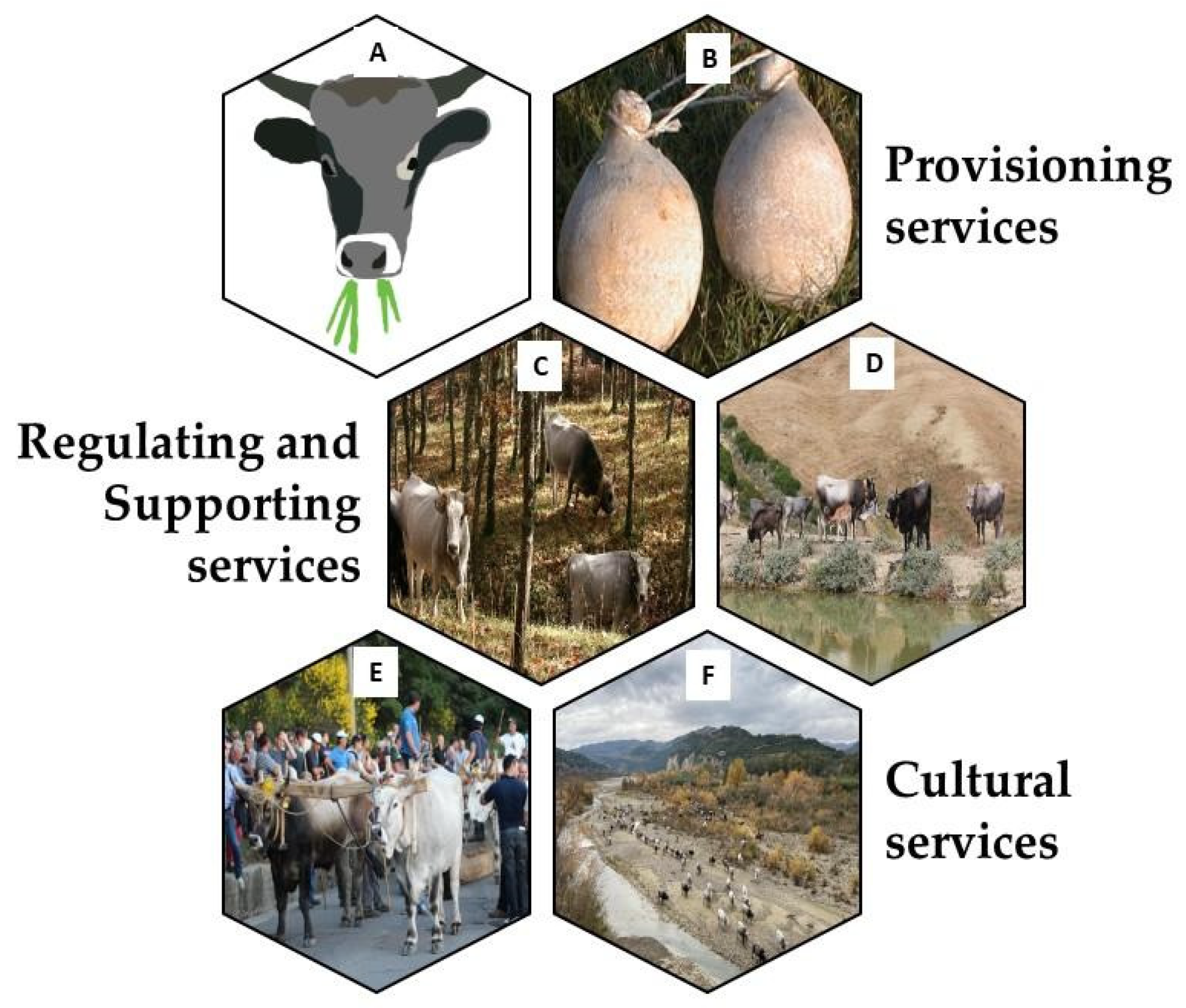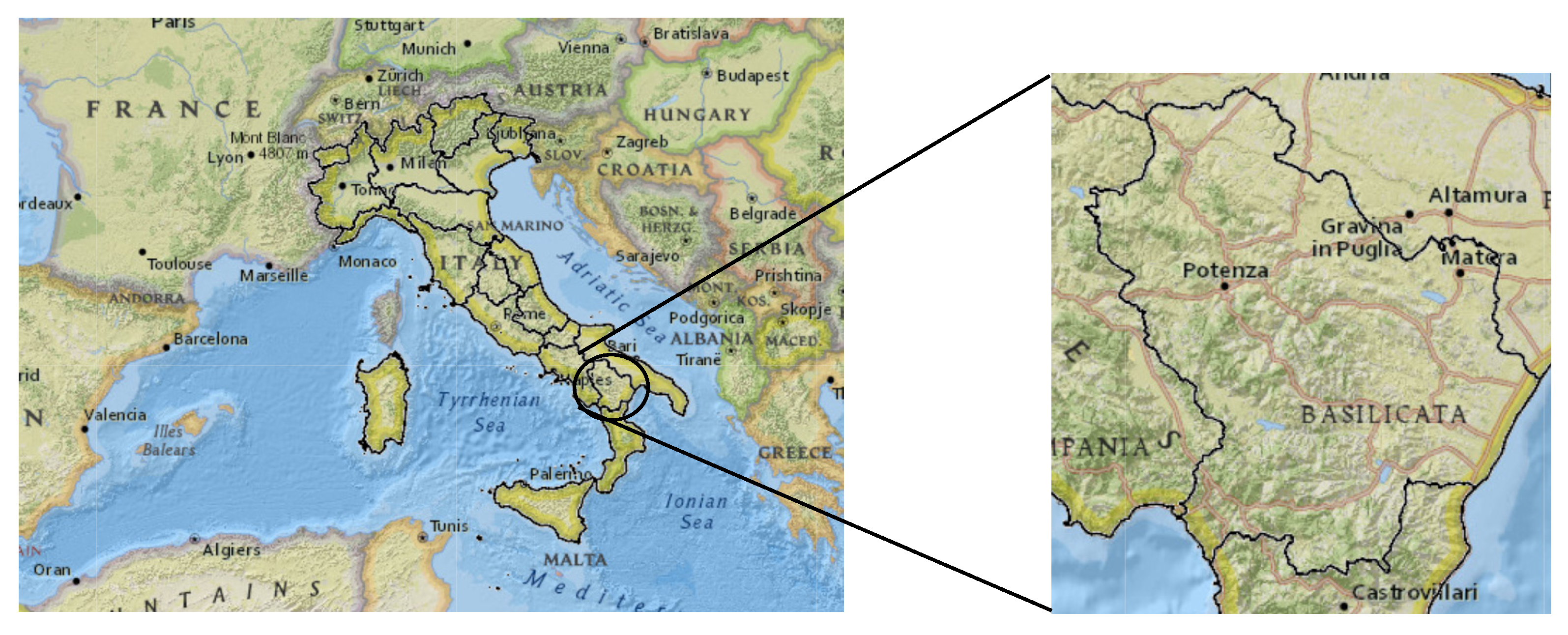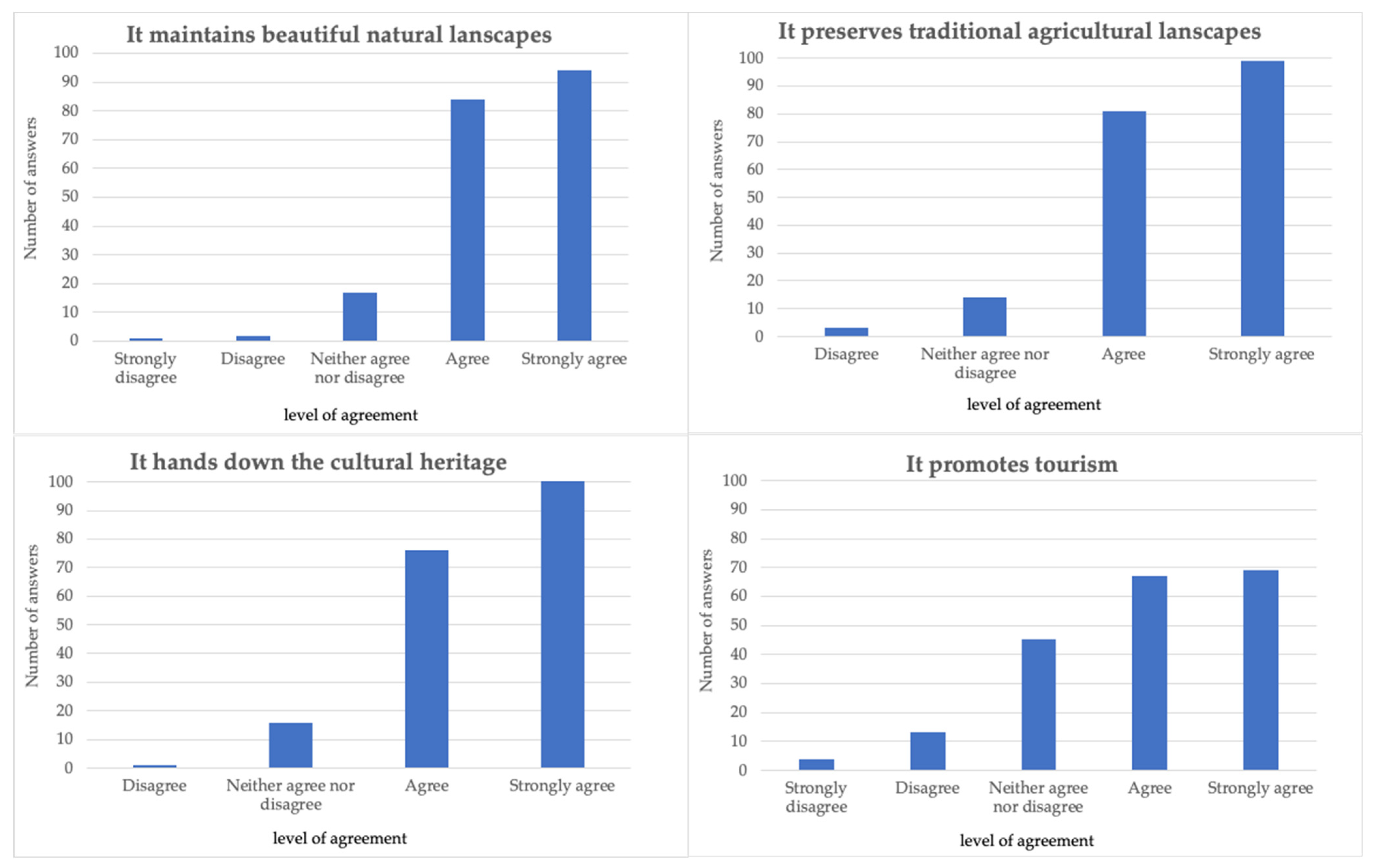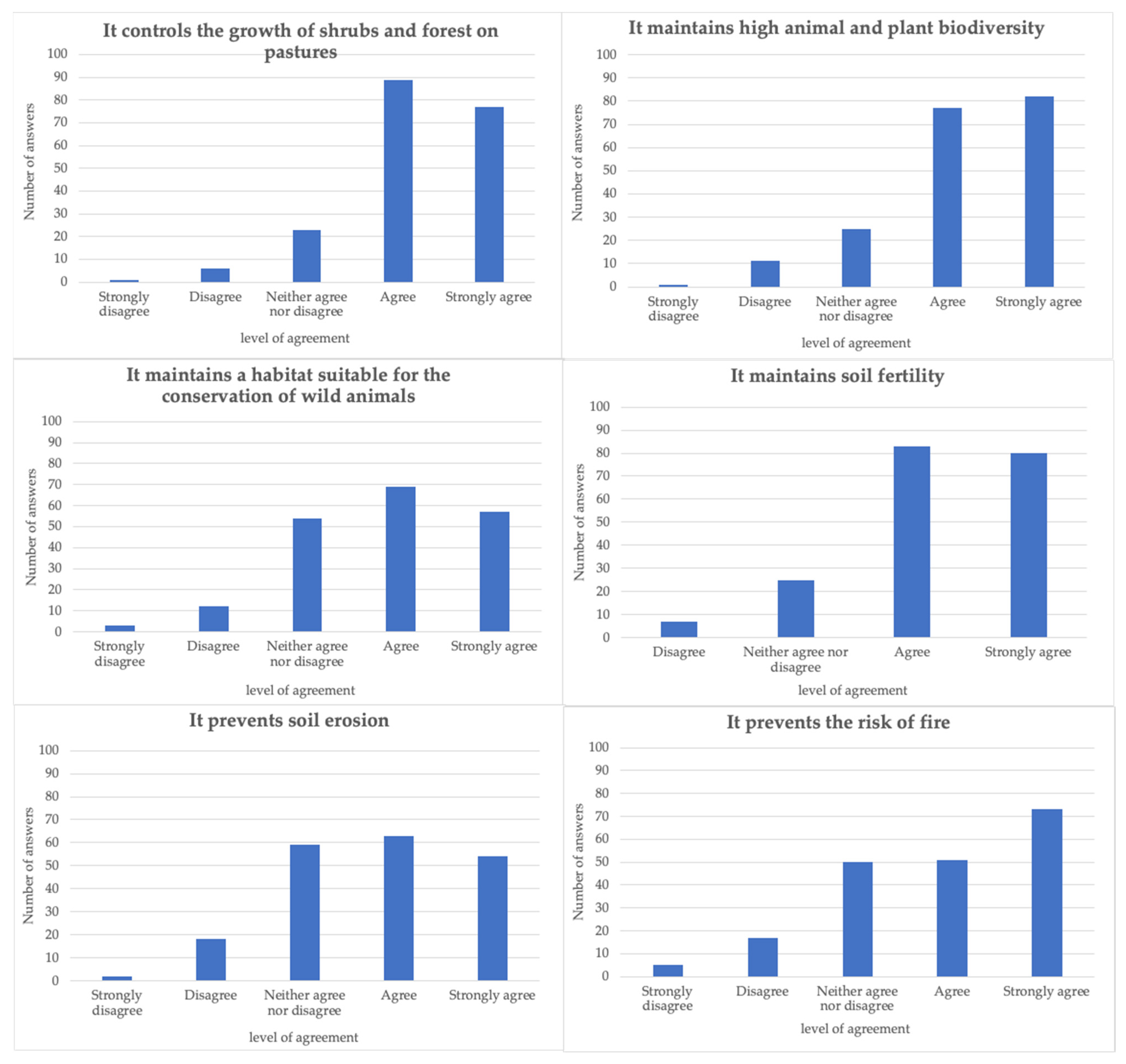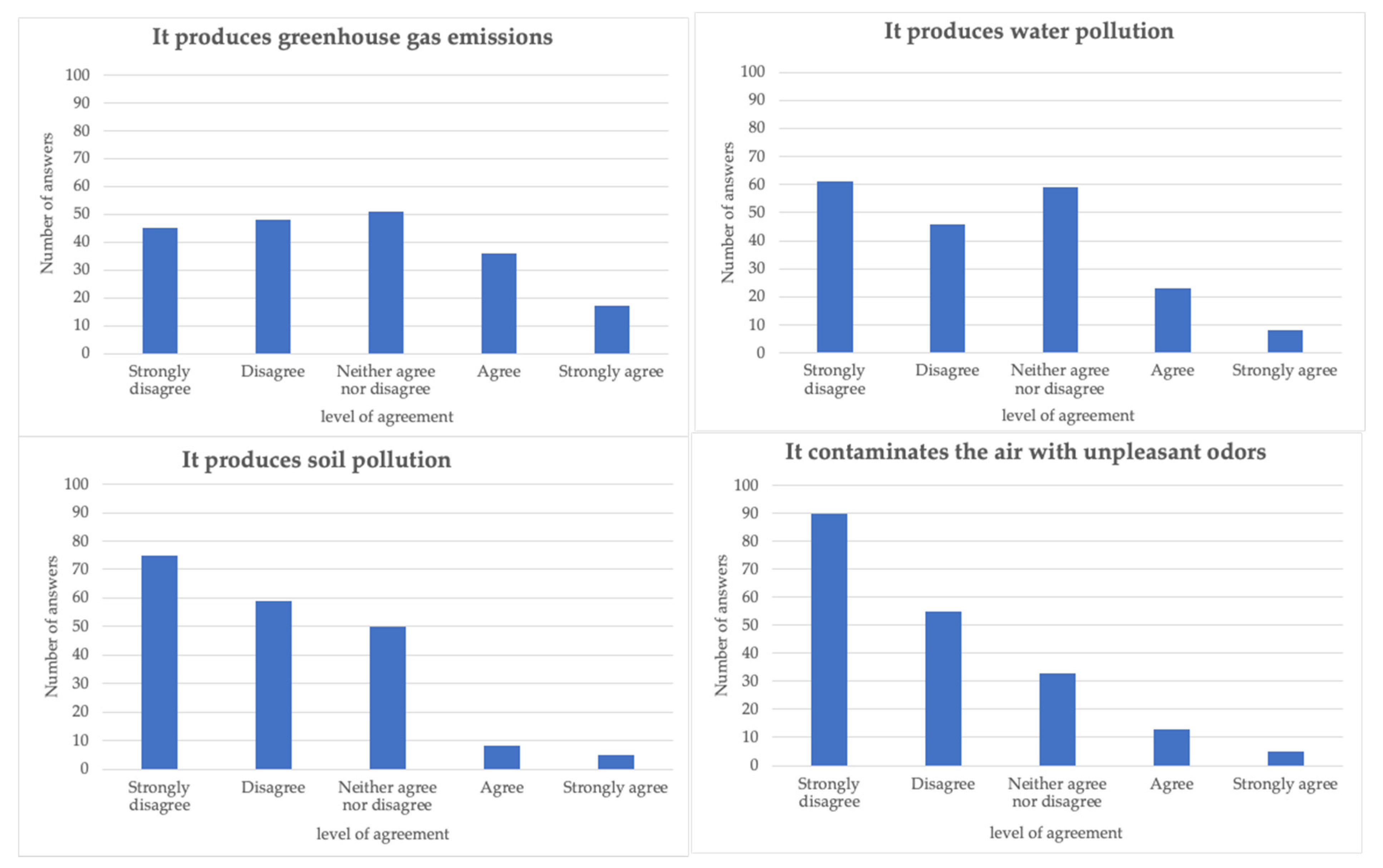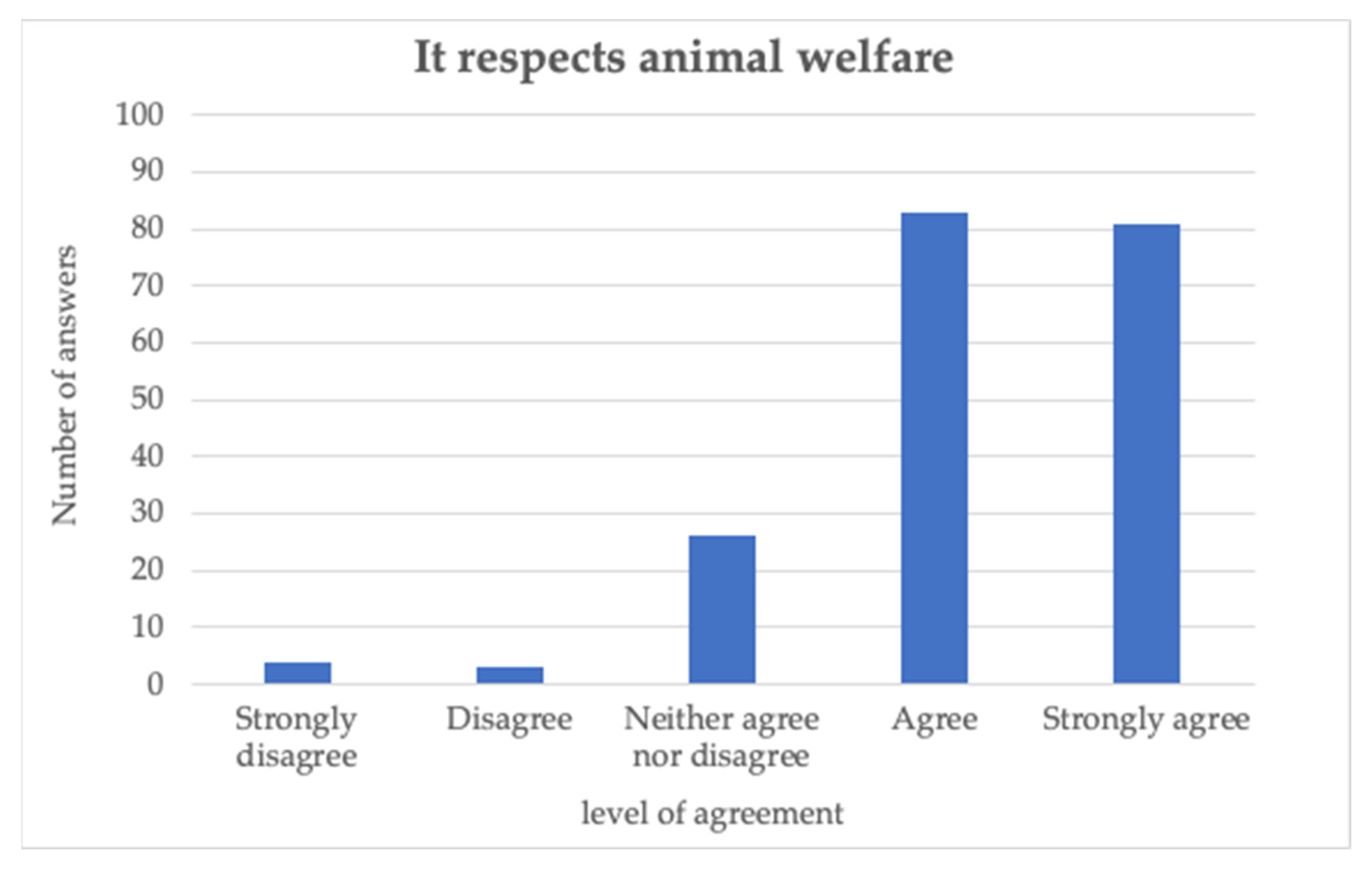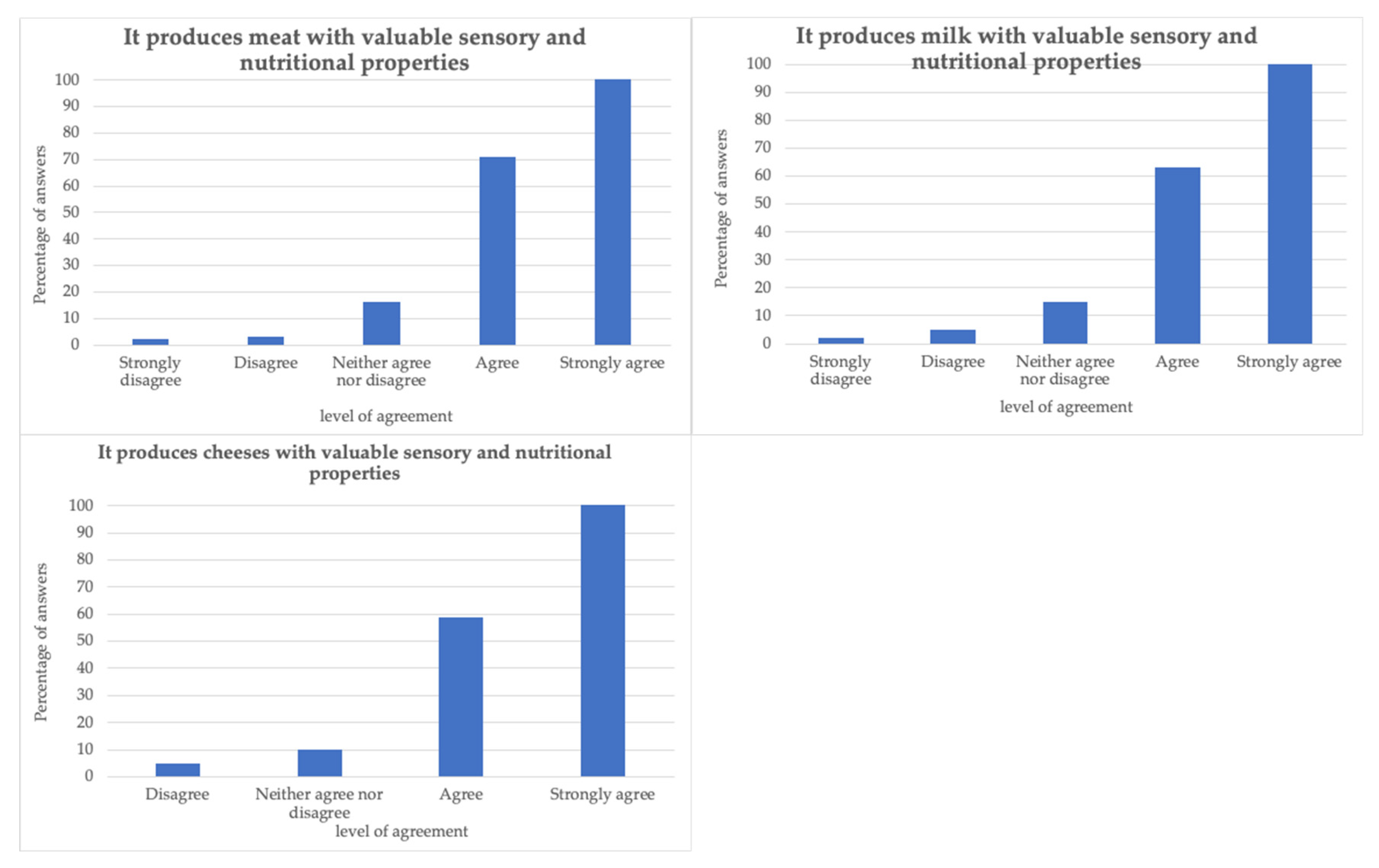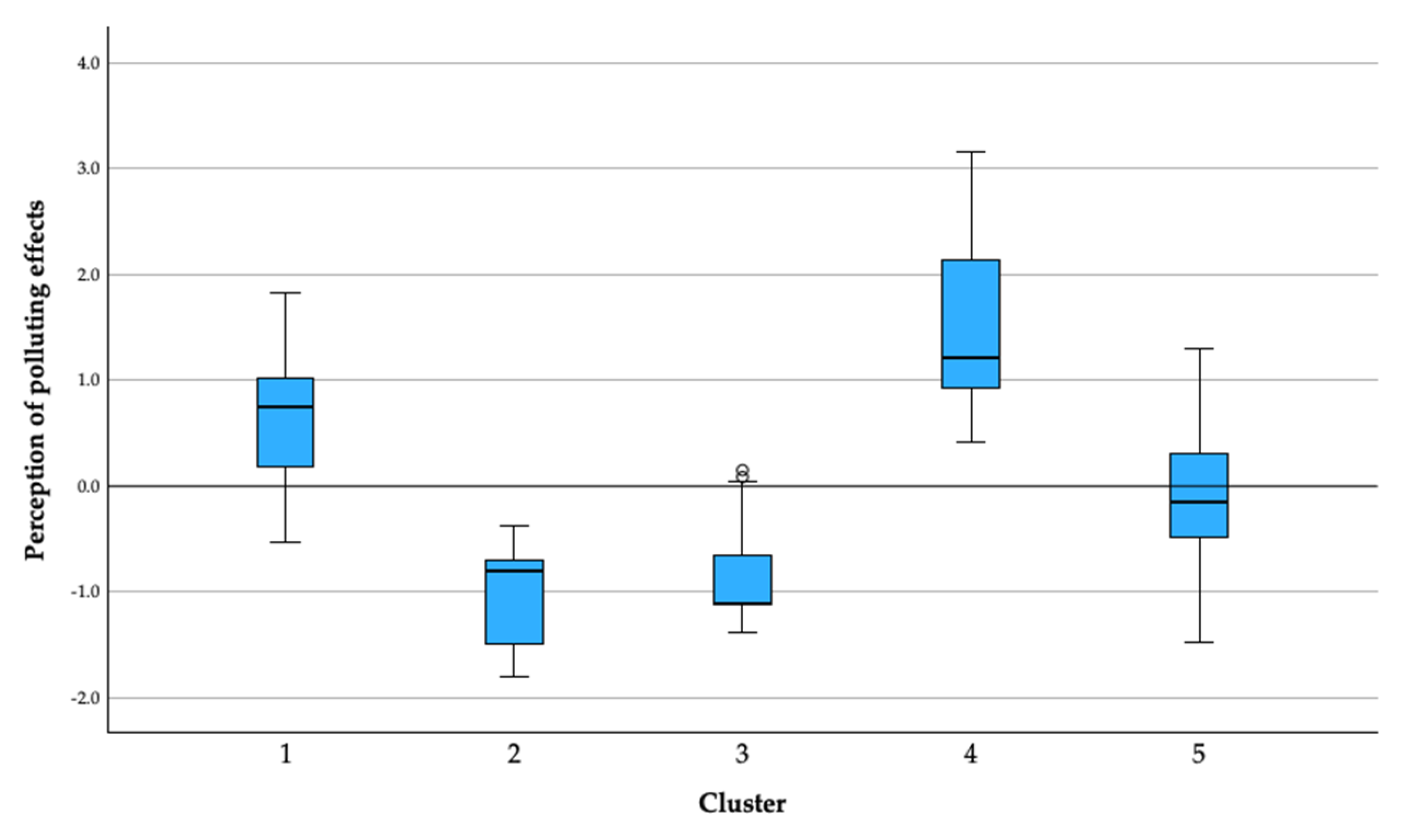1. Introduction
Land abandonment, ageing, and depopulation characterize many of southern Italy’s inner areas, marked by low resources’ productivity, scarce job opportunities, and a lack of social and economic infrastructures. Agriculture and livestock farming play a crucial role in maintaining these areas’ populations and landscapes. Therefore, European Union (EU) intervention in marginal areas mainly focused on ensuring a fair income level to guarantee the persistence of agriculture. This objective may imply considering all the goods and services agriculture can provide and valuing its social, cultural, and environmental contribution. Recognizing the capacity of agriculture to supply different ecosystem services (ESs) and the value people assign to them is the basis for policymakers to define interventions to compensate farmers for the positive externalities and multiple functions they carry out.
Currently, research on ESs is growing, and this subject is gaining greater recognition and dissemination, extending its reach beyond scientific experts to a broader audience [
1,
2,
3,
4]. The view of ESs, popularized through the Millennium Ecosystem Assessment in 2005 [
5], points to the connections between various ecosystems, including agroecosystems, and their impact on human well-being. Ecosystems can provide diverse services that hold significant importance for human welfare, health, livelihoods, and even our existence. Human well-being is a multifaceted concept often used interchangeably with personal happiness, quality of life, and health. It also encompasses broader aspects such as human welfare, robust social connections, and the protection of human rights [
6]. In a formal classification, ESs can be categorized into four distinct groups [
5].
Provisioning ESs include tangible or energy-related outputs, such as food, water, fuel, timber, and fiber.
Regulating services refer to the biophysical processes that provide benefits like climate regulation, flood prevention, waste treatment, and water purification. Ecosystems can also provide
supporting services, processes like soil formation, photosynthesis, or nutrient cycling, which are essential for producing all the other ESs. The last group of ESs includes
cultural services related to recreational, aesthetic, educational, and spiritual benefits the ecosystems can offer [
7].
Agroecosystems are characterized as “cultural landscapes” [
8] and play a vital role in delivering ESs. In marginal mountain areas, extensive livestock systems have played a significant role in establishing and sustaining semi-natural habitats. The key distinctions between these and other agricultural systems are evident in the utilization of traditional low-input practices and land management, particularly with meadows and pastures, especially in less favorable and less accessible areas. Additionally, they provide recreational and cultural experiences [
9]. ESs can be perceived as an interface between people and nature, a concept often exemplified by the “cascade model” [
6,
10]. This model emphasizes the interconnectedness of ecosystems and human well-being, illustrating how natural processes provide services that ultimately benefit individuals and society. It underscores the idea that ecosystem changes can have cascading effects on human livelihoods, demonstrating the intricate relationship between people and the environment. Moreover, the outcomes in the cascade [
11] model are goods and benefits that are relevant to people and, thus, reflect that in their value [
11]. This value can lead to choices related to ecosystems management, and, therefore, its assessment is crucial to address policy intervention [
11]. As a matter of fact, the value people assign to ecosystem services depends on people’s perception of benefits, which appears very heterogeneous, and also depends on their knowledge and awareness [
12]. There is rising interest in applying the ESs framework to research on mountain regions and environments [
13]. In a study conducted by Mengist et al. [
14], more than a thousand articles were published between 1992 and 2019 on ESs in mountain areas, and, of these, about half in recent years. This study analyzed the ESs associated with extensive livestock farming in marginal mountain areas. Nevertheless, there is an increasing need for information concerning the consequences of decisions on ecosystem services and human well-being [
15]. Unfortunately, a significant disparity exists between the research findings and the information requirements of decisionmakers and practitioners [
16].
The increasing worldwide demand for food has spotlighted livestock production as never before. This sector, encompassing both meat and dairy production, stands out as a significant contributor to the emissions of greenhouse gases driven by human activities. It is crucial to recognize that livestock farming plays a pivotal role in the ongoing issue of climate change and environmental sustainability. Furthermore, it is essential to appreciate that different livestock production methods can yield diverse outcomes concerning ESs. These outcomes are not limited solely to environmental impacts but also extend to agriculture’s social and economic aspects and policymakers’ decisions. Understanding these synergies and tradeoffs across various agrozootechnical sectors becomes paramount as we navigate the complex landscape of global food production. Several studies underlined the contribution of livestock farming to ESs provision. Some of them analyzed how the animal density and intensity of grassland management relate to biodiversity [
17,
18,
19,
20], soil erosion [
21,
22], and
regulating ESs [
23,
24]. Other studies focused on ranking and evaluating the environmental functions of livestock, such as pasture management, land use, and carbon sequestration [
25,
26,
27]. Several studies have approached ESs in cultural terms [
28,
29,
30,
31,
32], with relevance to the practice of transhumance [
33], which plays multiple roles in ESs provision, such as soil fertility maintenance, wildfire prevention, and cultural engagement with local populations. Other studies have observed how natural afforestation due to the abandonment of inland areas can have multiple effects on cultural ESs in social terms [
34]. Extensive rearing systems of native breeds may represent a valid opportunity to preserve natural ecosystems, supporting, at the same time, the socio-economic development of marginal areas, such as those of southern Italy. These marginal areas, in fact, are unsuitable for economically viable crop cultivation [
10]. An example of this farming is provided by the Podolian system (
Figure 1).
Podolian cattle represent a native breed, traditionally raised on pasture in southern Italy, with nocturnal shelter. This system is frequently established on low-fertility soils and permanent pastures characterized by low production, where herbage growth exhibits uneven distribution throughout the year. These cows graze on natural pasture year-round, with transhumance practiced by most farms to guarantee the animals a fairly constant quantity of grazing biomass. Podolian cows typically calve in the spring between February and April [
35]. Calves usually remain with their dams until 7 or 10 months of age, either at pasture or in provisional sheds or in loose barns; during this period, they benefit from suckling and natural weaning (
Figure 1). After weaning, calves may be finished in the same farm or sold and finished in a fattening farm, provided by a straw-bedded barn equipped with an outdoor paddock (
Figure 1). The slaughtering age varies from 16 to 18 months [
35].
Thus, rearing indigenous breeds like Podolian cattle is a way to use natural ecosystems while supporting economically active local communities sustainably [
36]. Indeed, Podolian cattle are known for their rusticity and remarkable adaptation to semi-arid regions with sparse vegetation [
37]. The Podolian system represents an interesting case study for providing ESs (
Figure 2) because it relates to several ESs typologies [
35]. As for
provisioning ES, the Podolian breed provides products with high nutritional and organoleptic values. The production of Podolian beef is guaranteed by the “BOVINO PODOLICO AL PASCOLO” registered trademark, according to the National Zootechnic Quality System, recognized at the national and community level (
Figure 2A). However, Podolian production is also famous for Caciocavallo Podolico cheese (
Figure 2B), a renowned stretched curd cheese [
35,
38], included in traditional agrifood products of the Basilicata region [
39]. As a typical product, this cheese is associated with a low environmental impact and the preservation of artisanal processing. The extensive pasture systems are traditional components of the regional landscape and largely contribute to maintaining biodiversity and landscape in rural areas (
Figure 2C,D) [
35,
40,
41].
For all these considerations, this study represents a first attempt to understand the perception by stakeholders (breeders and potential consumers) of the multifunctional role played by the Podolian breed and of the important role of the breeders themselves as “guardians” of the territory and cultural heritage of the marginal areas of southern Italy.
4. Discussion
The participants of the survey showed a highly positive perception of the role played by extensive rearing of Podolian cattle on the landscape and territory for keeping local culture and traditions, thus promoting the development and preservation of marginal areas. In a study conducted in the French territory, nearly all the respondents stated that landscapes shaped by agricultural activities involving livestock could be considered “cultural” as they unquestionably play a significant role in shaping the unique identity of each region [
50]. In a similar study conducted in an Alpine environment, the aspects related to the natural landscape and cultural services received equally high scores [
45,
51]; this underscores the universal recognition of the significance of maintaining the pristine beauty of the mountain environment and the promotion of its rich cultural heritage as integral components of sustainable practices and regional identity across different regions. It is interesting to note that, in a particular area of Sweden [
52], the cheese consumers and producers do not have strong connections to the local terrain and its history. However, they still place considerable importance on cultural heritage, food traditions, the sense of place and its historical context, and the preservation of natural landscapes and grazing animals. This observation highlights that these values remain significant, even when considered in different contexts. The idea is that these elements hold a profound place in the minds of individuals [
53], even in settings where the historical and geographical connections may not be as pronounced. It underlines the universal appreciation for cultural heritage, the intrinsic bond between people and their surroundings [
53], and the enduring allure of unspoiled natural environments and traditional agricultural practices, transcending geographical and cultural boundaries.
Surprisingly, our results show that many interviewees do not perceive Podolian livestock as relevant to promoting tourism. That may be due to people’s perception of tourist activity as solely focused on monuments and pictorial art. However, this perception contrasts with what emerges in many actual situations and underestimates the economic potential of livestock provisioning ESs. Several studies in European and non-European countries have highlighted the numerous benefits of cheese production and marketing in terms of tourism activity [
54,
55]. This phenomenon underscores the pivotal role that cheese can play as a catalyst for tourism development, stimulating economic growth, fostering cultural exchanges, and enhancing culinary tourism experiences. The connection between a region and its unique cultural identity and traditions is a significant factor that motivates customers to buy traditional products [
56]. This is supported by the latest data from the XX ISMEA-Qualivita report [
57], which indicates a growing preference for local and traditional foods. These products are often perceived as being of higher quality [
58], more sustainable [
56], and possessing a solid cultural identity compared to industrial foods. Notably, an important work by Fusté-Forné (2020) [
59] examined the intertwined relationship between cheese production and tourism, shedding light on the symbiotic dynamics that unfold when artisanal cheese-making traditions intersect with the demands of a burgeoning tourist industry.
As for provisioning ESs, in this study, most of the respondents perceived dairy and beef provided by the Podolian system to have high nutritional and sensory properties. Sensory properties, such as the appearance, odor, flavor, taste, and texture of foods detectable by human senses, are particularly important to characterize the peculiarities of typical products. Recent studies stated that the traditional Caciocavallo Podolico cheese-making protocol is the strategy to harmonize the microbial evolution and to almost constantly maintain the final characteristics of this cheese [
60]. In addition, consumer perception of products deriving from traditional pasture-based farming, such as the Podolian system, tends to be more positive compared with products obtained from intensive farming practices [
61].
Regarding environmental effects, the interviewees’ perception is coherent with findings from studies conducted in Mediterranean natural parks, where livestock grazing was found to influence the dynamics of shrubs [
62]. Recent studies conducted in China have observed that the advancement of shrubs in Alpine ecosystems and meadows leads to changes in soil properties, increases the risk of soil erosion, and results in a reduction in soil moisture and, consequently, in soil water content [
63], although other authors have observed in Mediterranean environments how the invasion of shrubs and climate change increase the susceptibility of wooded pastures to drought [
64]. Similar results in soil fertility, soil erosion, and wildfire risk assessment have been observed in a recent study conducted in an Alpine and Mediterranean environment [
51,
65]. These findings highlight the interconnectedness of ESs in high-altitude regions. The impact of changing vegetation patterns on soil fertility can have cascading effects on nutrient availability, which in turn can affect the provision of essential ESs like habitat support and water purification.
Furthermore, the increased risk of wildfires due to altered vegetation dynamics underlines the significance of these ecosystems in providing fire regulation services and carbon sequestration [
66]. The findings on the perception of the polluting effects of Podolian livestock are more controversial. The perception of the role of this livestock system in the emission of greenhouse gases and water and soil pollution highlights how people often equate it with intensive farming. Similar findings have also been observed by [
51] in an Alpine environment. Conversely, intensive beef production systems have been observed to result in significant water quality issues, mainly due to the transportation system and feed production [
67]. The neutral score expressed by many respondents towards water pollution issues might be ascribed to limited knowledge of the husbandry techniques and practices employed in rearing Podolian cattle.
Most of the sample perceived the Podolian system as respectful of animal welfare. In extensive rearing systems, a diet based mainly on forage and fibrous foods prevents the onset of pathologies and abnormal behaviors, such as stereotypes [
68]. Indeed, it is widely documented that extensive rearing conditions may positively affect animal welfare [
37]. During grazing, animals can express their natural ethogram, with positive effects on cellular immune responsiveness and thus on their health [
37].
In addition, consumers clearly express preferences for products obtained using animal-welfare-friendly techniques [
69], and information on animal welfare can positively affect the quality perception of lamb meat and beef [
70].
5. Conclusions
Our study shows, for the first time, the perception of ESs in the extensive Podolian cattle farming system in the Basilicata region, which tends to be generally positive and highly positive. The positive perception of Podolian cattle farming may also be due to the broad familiarity of the Lucanians toward this breed, which is very appreciated for its distinctive characteristics and rusticity, making it well-suited for the rugged and wooded mountainous terrain of the Basilicata region.
However, this study offers valuable insights into the intricate relationship between agriculture, culture, and the environment. It emphasizes that traditional, sustainable farming practices, like the Podolian system, can be pivotal in a region’s economic, cultural, and ecological recognition.
The perception of ESs is the basis for defining their value and identifying intervention strategies to preserve the Podolian rearing system in marginal areas. Different socio-economic groups can have different perceptions of the ESs extensive livestock farming can provide. Moreover, the perception can be related to the knowledge of livestock practices, and this suggests a need for increased awareness and education on the environmental impacts different agricultural practices have on environmental components.
That highlights the need for a deeper analysis of the link between the socio-economic characteristics of the population and the perception of (dis)service provided by extensive livestock systems, as well as between ESs perceptions and the value people assign to them.
Moreover, further research is needed to unlock the full potential of such farming systems and their role as drivers of tourism and high-quality product production in the Basilicata region.
